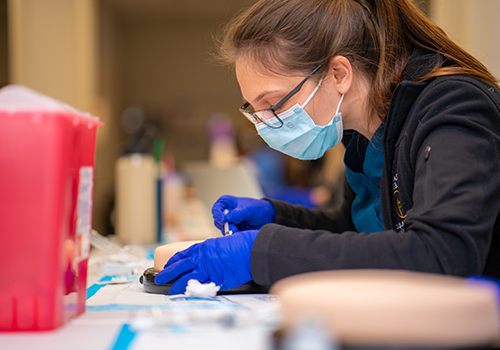
Students admitted to the nursing program are expected to be able to complete all curriculum requirements, which include physical, cognitive, sensory, and behavioral core competencies that are essential to the functions of the entry-level professional nurse.
These core competencies are considered to be the minimum and essential skills necessary to protect the public. These abilities are encountered in unique combinations in the provision of safe and effective nursing care and can meet the criteria with or without reasonable accommodations.
Students who are unsure if they can meet these criteria because of disability, or know they will need help in meeting them, must contact St. Bonaventure's
Office of Accessibility Services and Academic Support to discuss the use of reasonable accommodations. Reasonable accommodations will be provided that do not substantially alter the requirements or nature of the program.
Applicants must meet the following technical standards:
Cognitive criteria
- recall, collect, analyze, synthesize, and integrate information from a variety of sources
- measure, calculate, reason, analyze, and synthesize data
- problem solve and think critically in order to apply knowledge and skill
- communicate verbally, and through reading and writing, with individuals from a variety of social, emotional, cultural, and intellectual backgrounds
- relay information in oral, written, and electronic form effectively, accurately, reliably and intelligibly to individuals and groups, using the English language
Examples of learning activities found in the nursing curriculum and related to industry standards:
- process information thoroughly and quickly to prioritize and implement nursing care
- sequence or cluster data to determine client needs
- develop and implement a nursing plan of care for clients in acute, long-term, and community settings
- discriminate fine/subtle differences in medical word terminology
- report verbally and in writing client data to members of the health care team
- read and comprehend medical orders and client information found in the medical record
- perform math computations for medication dosage calculations both with and without a calculator
Physical Criteria
- move efficiently enough to meet the needs of patients in a timely fashion
- coordinate fine and gross motor movements
- coordinate hand/eye movements
- maintain balance from any position
- negotiate level surfaces, ramps, and stairs
- function with both hands free for performing psychomotor tasks
- maneuver in small areas
- attend to cognitive and psychomotor tasks for up to 7-12 hours
Examples of learning activities found in the nursing curriculum and related to industry standards:
- transfer patients/clients in and out of bed from stretchers and wheelchairs
- turn and position patients
- control a fall by slowly lowering client to the floor
- perform cardiopulmonary resuscitation (CPR)
- lift or move (turn, position) clients or objects; pull or push objects, weighing up to 50 pounds
- reach to shoulder or higher level to place or access equipment such as intravenous fluid bags; bend or squat to access equipment below bed level
- carry equipment and supplies to the client bedside
- manipulate small equipment and containers, such as syringes, vials, ampoules, and medication packages to administer medications without extraneous movement, contamination, or destruction
- accurately place and maintain position of stethoscope for detecting sounds of bodily functions
- record data with a pen or graphics and other flow sheets
- operate a computer
- dispose of needles in sharps container
- complete assigned periods of clinical practice (8-12 hour shifts, days, evenings, or nights)
Sensory Criteria
- acquire information from demonstrations and experiences, including but not limited to information conveyed through online coursework, lecture, small group activities, demonstrations, and application experiences
- collect information through observation, listening, touching, and smelling
- use and interpret information from diagnostic maneuvers
Examples of learning activities found in the nursing curriculum and related to industry standards:
- detect changes in skin color or condition. (pale, ashen, grey, or bluish)
- detect a fire in the client care environment
- draw up a prescribed quantity of medication into a syringe
- observe clients in a room from a distance of 20 feet away
- detect sounds related to bodily functions using a stethoscope
- detect audible alarms generated by mechanical systems such as those that monitor bodily functions, fire alarms, and call bells
- observe and collect data from recording equipment and measurement devices used in client care
- communicate with client and members of the health care team in person and over the phone in a variety of settings including isolation and the operating room where health team members are wearing masks and there is background noise
- detect foul odors of bodily fluids or spoiled foods
- detect smoke from burning materials
- detect changes in skin temperature
- detect unsafe temperature levels in heat-producing devices used in client care
- detect anatomical abnormalities, such as subcutaneous crepitus, edema, or infiltrated intravenous fluids
- feel vibrations such as an arterial pulse
Behavioral Criteria
- demonstrate emotional stability to function effectively under stress and adapt to changing environments
- maintain effective, mature, and sensitive relationships with others
- examine and modify one’s own behavior when it interferes with others or the learning environment
- possess attributes that include compassion, empathy, altruism, integrity, honesty, responsibility, and tolerance
- establish a therapeutic relationship and communicate in a supportive manner